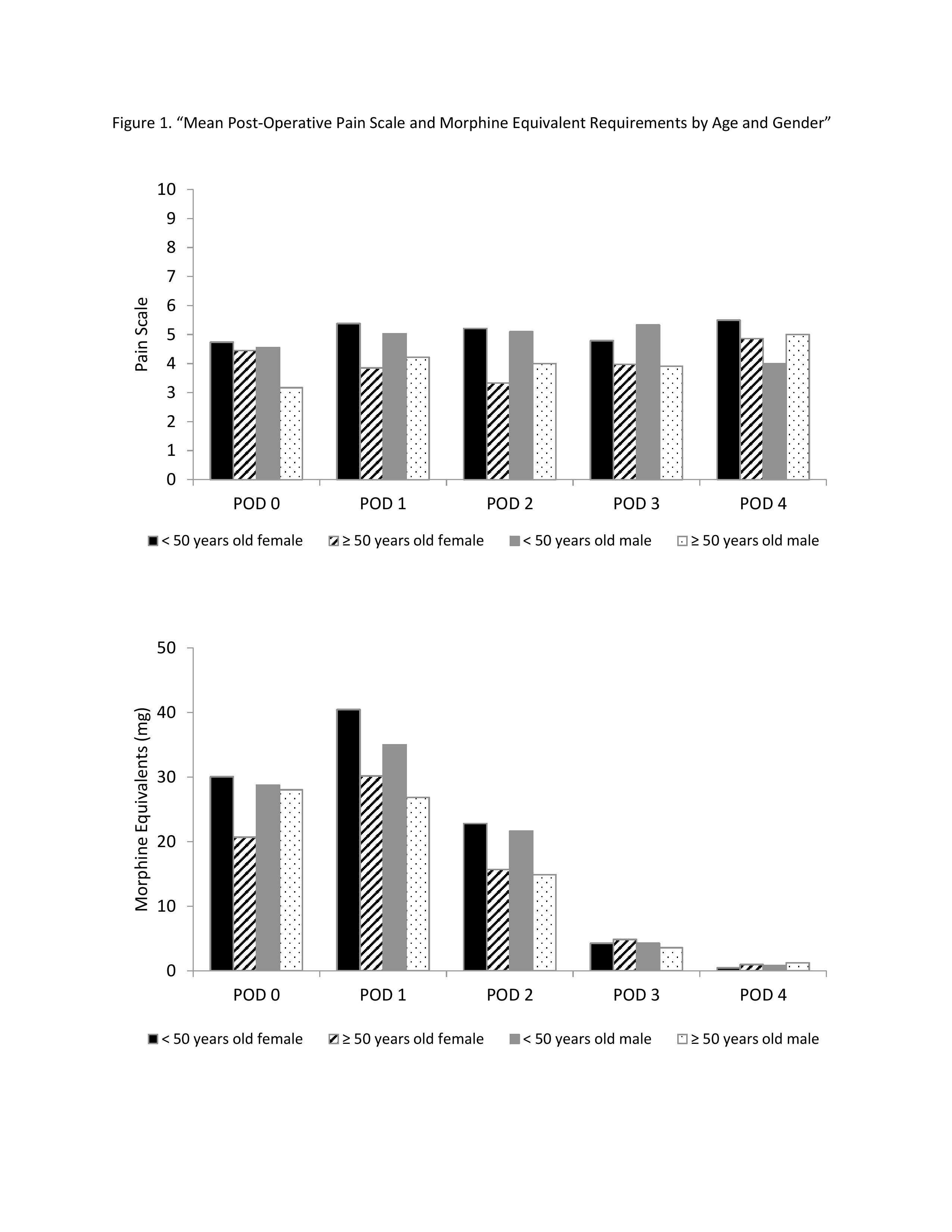Analgesia and Control of Pain Following Laparoscopic Donor Nephrectomy
1Pharmacy, NewYork-Presbyterian Hospital, New York, NY, 2Surgery, Columbia University Irving Medical Center, New York, NY
Meeting: 2019 American Transplant Congress
Abstract number: B272
Keywords: Donation, Kidney transplantation, Pain
Session Information
Session Name: Poster Session B: Kidney Living Donor: Quality and Selection
Session Type: Poster Session
Date: Sunday, June 2, 2019
Session Time: 6:00pm-7:00pm
 Presentation Time: 6:00pm-7:00pm
Presentation Time: 6:00pm-7:00pm
Location: Hall C & D
*Purpose: Laparoscopic living donor nephrectomy (LapDNx) for renal transplantation is a standard surgical practice. Effective pain management following this operation is essential. The purpose of this study is to evaluate age- and gender-based differences in pain reporting and analgesic requirements among patients who have undergone LapDNx, and evaluate the safety/tolerability of a ketorolac-based regimen.
*Methods: Single-center, retrospective study of adult patients who underwent LapDNx during a 36-month period. Standard analgesics after LapDNx included IV ketorolac 15 mg every 6 hours in combination with as-needed opioids. The primary endpoint of analgesic requirement was calculated from time of LapDNx to hospital discharge and reported in morphine equivalents (ME). Patient-reported pain scores were reported from post-operative day (POD) 0 to hospital discharge.
*Results: During the period of study 321 patients (56% women) underwent LapDNx. The majority of patients had their left kidney removed (89%) and had incisions almost identical in distribution and size. Patient-reported pain scores are summarized in Figure 1a. Intra-operative duration of LapDNx surgery (Table 1) and opioid oral ME were similar between groups; <50 years of age 31.2 ± 25.5 mg vs. ≥50 years of age 31.3 ± 28.9 mg (p= 0.96). Post-operative ketorolac doses were similar among patients in the two groups while ME on POD 0, POD 1, and POD 2 were statistically significantly higher among patients <50 years of age (Figure 1b). Though younger patients reported a higher mean pain score on POD 0 than older patients (4.7 ± 2.5 versus 3.9 ± 2.6, respectively), the difference was not statistically significant until POD 1 and POD 2 [(POD 1: 5.2 ± 1.7 vs. 3.9 ± 3.5, p< 0.0001) and (POD 2: 5.1 ± 2.2 vs. 3.6 ± 2.4, p< 0.0001)]. Safety and tolerability of ketorolac was similar between age groups, with no clinically significant differences in blood pressure or changes in hematocrit.
*Conclusions: Patients younger than 50 years of age, especially women, require more analgesics after LapDNx when compared to those who are older. Clinicians should anticipate greater opioid requirements among younger donors, especially women.
|
<50 years old (n=208) |
≥50 years old (n=113) | p value | |
| Age in years | 35 ± 8.5 | 56 ± 5.0 | <0.0001 |
| Female, n (%) | 113 (54) | 68 (60) | 0.19 |
| BMI, (kg/m2) | 27 ± 5.6 | 27 ± 5.4 | 0.98 |
| Caucasian, n (%) | 121 (58) | 75 (66) | 0.11 |
| Left kidney removed, n (%) | 188 (90) | 101 (89) | 0.17 |
| LapDNx operating room time in hours | 4.7 ± 0.8 | 4.8 ± 0.9 | 0.63 |
| Hospital length of stay in days | 2.2 ± 0.7 | 2.3 ± 0.9 | 0.30 |
To cite this abstract in AMA style:
Hedvat J, Lange NW, Sandoval P, Ratner LE, Tsapepas DS. Analgesia and Control of Pain Following Laparoscopic Donor Nephrectomy [abstract]. Am J Transplant. 2019; 19 (suppl 3). https://atcmeetingabstracts.com/abstract/analgesia-and-control-of-pain-following-laparoscopic-donor-nephrectomy/. Accessed December 16, 2025.« Back to 2019 American Transplant Congress

